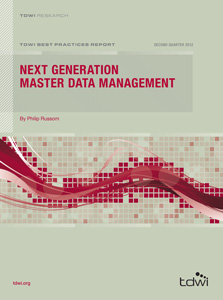
TDWI Best Practices Report | Next Generation Master Data Management
April 2, 2012
Master data management (MDM) is one of the most widely adopted data management disciplines of recent years. Finding consensus definitions for business entities and then applying them consistently are critical success factors for important cross-functional business activities such as business intelligence (BI), complete views of customers, operational excellence, supply chain optimization, regulatory reporting, compliance, mergers and acquisitions, and treating data as an enterprise asset. These business reasons are so compelling that many organizations have already deployed their first or second generation of MDM solutions. The challenge now is to move on to the next generation.
This research report reveals that we can expect the strongest growth among MDM features and functions for real-time, collaboration, data synchronization, tool use, and multistructured data. Good growth is also coming with MDM functions for workflow, analytics, federation, repositories, and event processing. Some MDM options will experience limited growth, because they are saturated (services, governance, quality) or outdated (batch processing and homegrown solutions).
Download this report to help your organization understand all that MDM now offers, so you can successfully modernize and build up your best practices in master data management. The report catalogs and discusses new user practices and technical functions for MDM, and it uses survey data to predict which MDM functions will grow most versus those that will decline—all to bring readers up to date so they can make informed decisions about MDM strategy.
Download the full, 36-page TDWI Best Practices Report for an in-depth look at the priorities, challenges, trends, and recommendations for implementing next generation MDM.
Content Provided by
TDWI, IBM, DataFlux, Oracle, SAP, Talend